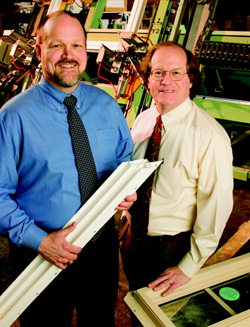Currently, the dealer’s window plant runs two vinyl production lines manned by 31 people, 70 percent of whom are cross-trained to work at different stations throughout the facility, says plant manager Jeff Starbird. The two lines can shift into assembling different window sizes and glass inserts without having to stop and retool the machinery. Other areas inside the plant where Wheeler’s investment in equipment is evident include its $110,000 glass-cutting optimizer and a new method for bending vinyl (the specifics of which Wheeler’s officials asked to remain confidential) that the company introduced in 2005 and is expected to save $30,000 a year.
By moving window production to West Rome, Wheeler’s doubled the space inside its headquarters manufacturing plant for the production and warehousing of doors to 100,000 square feet. DeYoung says this extra space allows Wheeler’s to expand its breadth of lines and styles. “Special order is a very small percentage of sales in this market, but ‘made to order,’ which includes grille patterns and hinge types, is two-thirds of the business,” he explains. The door plant stocks about $1.2 million in inventory at cost but, like the dealer’s other plants, carries no more than two days’ worth of shipments.
Making doors is a pretty basic process, and this plant employs 35 people who work at seven assembly tables. But technology has crept in on the distribution side. For example, groups of doors are placed onto rotating pallets and shrink-wrapped automatically, which DeYoung says reduces damage and helps get more product onto delivery trucks. (Wheeler’s two-steps all of its doors through its yards.) Within 18 months, Wheeler’s intends to put bar codes on the labels of its doors to identify the customers they’ve been sold to.
Another 100,000 square feet inside the headquarters plant—a former textile mill dating back to 1929 that Wheeler’s purchased in 1983—and a smaller plant in Cummings, Ga., are dedicated to the production of trusses and wall panels. Before Wheeler’s got into truss making in 1998, Jim Manis visited 40 different operations for best practices. In its first year, the company sold less than $1 million in trusses, but since then production has picked up to its current rate of about 65,000 board feet a day for structural components, or three-quarters of a day’s worth of inventory. “When we build more than a day ahead of deliveries, we’ve gotten burned,” explains Manis. The plants and some yards employ truss designers.
One idea Manis brought back from his sojourns was an assembly-line system called Auto-Set, where each station shows mechanical stops numbered for lining up the boards to jig out a truss. By using this system, Wheeler’s can train a new lineman in three weeks. This system also cuts down on production waste, says Manis. Additionally, Wheeler’s recently started measuring its plants’ fill rates against their inventories, and it plans to extend those measurements to jobsite fill rates later this year. But Manis and DeYoung note that the company’s delivery efficiency is sometimes hampered by its difficulties in finding and keeping qualified drivers.
Efficient Construction Wheeler’s officials expect installed sales in 2006 to sustain last year’s 20 percent growth rate, and to boost component and millwork sales, particularly wall panels, which DeYoung admits are a “tough sell” in a cheap-labor market like Atlanta. “We’d almost prefer that [builders] buy panels installed,” he states.
Jeff Siewert, construction manager for Acworth, Ga.–based Mercury Homes, planned to stick-build a 20-unit townhouse complex he’s supervising in Douglasville, Ga. But he says Rick Ariail, Wheeler’s director of installed sales with whom he has a longstanding relationship, “talked him into it.” “If there’s any kind of service issue, I know he’ll fix it,” says Siewert. What’s more, “The size of the roof [on each building] would take one and a half times longer to complete if we weren’t using trusses and panels,” he says, estimating that the time savings on the project will be 25 to 30 percent.
Half of Wheeler’s installed sales comes from framing, and Ariail, who has been with Wheeler’s for more than 12 years, concedes that framing contractors need convincing that they can make more money using components because they’ll build homes faster and reduce their product waste. “A repetitive house can be panelized in two and a half days,” he says.
Ariail and his team of 17 territory managers promote installation as a value-added service for builders because “they don’t have to chase down subs and only cut one check per project,” he states. Janet Hollenbeck couldn’t agree more. Her company, Hollenbeck Homes in Canton, Ga., started using Wheeler’s to install siding five years ago; now “We use them for just about everything they install: framing, siding, decks, trusses, wall panels.” Hollenbeck did $500,000 with Wheeler’s last year, and she says the difference between the dealer’s service and hiring subs on her own “is huge.” “Wheeler’s stands behind its work and carries insurance,” she says. “Crews you hire might not be living in this country next year.”
Sounding Board As installed sales expand, Wheeler’s next challenge will be to “get our hands around the accounting,” says the dealer’s controller, Frank Bibb, “to assess which [projects] are more productive.” Early goals include getting accurate job completion dates from the field into Wheeler’s computer system and properly allocating overhead.

